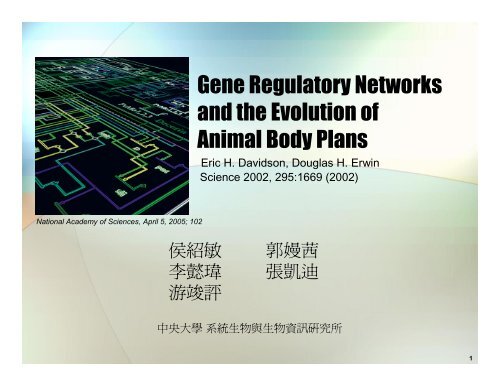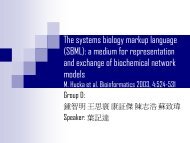Gene Regulatory Networks and the Evolution of Animal Body Plans
Gene Regulatory Networks and the Evolution of Animal Body Plans
Gene Regulatory Networks and the Evolution of Animal Body Plans
Create successful ePaper yourself
Turn your PDF publications into a flip-book with our unique Google optimized e-Paper software.
Eric H. Davidson, Douglas H. Erwin<br />
Science 2002, 295:1669 (2002)<br />
National Academy <strong>of</strong> Sciences, April 5, 2005; 102<br />
<br />
<br />
<br />
<br />
<br />
<br />
1
• Development <strong>of</strong> <strong>the</strong> animal body plan<br />
• Different rate in <strong>the</strong> evolution<br />
• Developmental GRNs features <strong>and</strong> four<br />
components<br />
• How GRNs explain changes <strong>of</strong> <strong>the</strong><br />
evolution<br />
• Summery<br />
2
• blueprint<br />
<br />
• symmetry, # <strong>of</strong> body segments <strong>and</strong> #<br />
<strong>of</strong> limbs<br />
• tube-within-a-tube vs. sac-like<br />
• triploblasty<br />
http://users.tamuk.edu/kfjab02/Biology/Introzoology/b1313_ch16.htm<br />
3
triploblasty<br />
Baer's laws for embryology:<br />
Two rules from four<br />
1. The general characters <strong>of</strong><br />
<strong>the</strong> group to which an<br />
embryo belongs appear in<br />
development earlier than<br />
<strong>the</strong> special characters.<br />
2. The less general structural<br />
relations are formed after<br />
<strong>the</strong> more general, <strong>and</strong> so on,<br />
until <strong>the</strong> most specific<br />
appear.<br />
4
Schematic representation <strong>of</strong><br />
sea urchin embryo development<br />
P. Oliveri, E. H. Davidson, Curr. Opin. <strong>Gene</strong>t. Dev. 14, 351(2004).<br />
5
4700 ma<br />
<br />
Major diversification <strong>of</strong> life in <strong>the</strong> Cambrian<br />
Explosion. Many fossils<br />
Marinoan glaciations<br />
Possible "snowball Earth" period.<br />
Followed by Good fossils <strong>of</strong> multi-celled animals.<br />
oxygen levels in <strong>the</strong> atmosphere increased<br />
630~8<br />
50 ma<br />
<br />
<br />
http://en.wikipedia.org/wiki/Geologic_time_scale<br />
6
<strong>Body</strong> plans dev<br />
Different combination <strong>of</strong><br />
TF, cis-regulatory module<br />
Temporal , spacial<br />
GRN<br />
GRN structure is inherently hierarchical, because each<br />
phase <strong>of</strong> development has beginnings, middle stages, <strong>and</strong><br />
progressively more fine-scale terminal processes.<br />
7
<strong>Regulatory</strong> genes cis-regulatory modules<br />
linkages<br />
cis-regulatory modules:<br />
eg. enhancer, silencer , insulator<br />
> 300bp<br />
> 10 binding sites<br />
> 4 transcription factors<br />
8
intercellular<br />
component<br />
transcription<br />
repess<br />
Known<br />
sequence<br />
P. Oliveri, E. H. Davidson, Curr. Opin. <strong>Gene</strong>t. Dev. 14, 351(2004).<br />
9
Sea urchin VS. Starfish<br />
Kingdom: <strong>Animal</strong>ia<br />
Phylum: Echinodermata<br />
Class: Echinoidea<br />
Kingdom: <strong>Animal</strong>ia<br />
Phylum: Echinodermata<br />
Class: Asteroidea<br />
10
Kingdom<br />
biological classification<br />
From Wikipedia<br />
11
Q1: why So little change in phylum<strong>and</strong><br />
superphylum-level body plans<br />
since <strong>the</strong> Early Cambrian? Like<br />
Tetrapod, segmented.<br />
Q2: why Great changes have<br />
subsequently occurred within phyla<br />
<strong>and</strong> classes?<br />
12
• Kernels - inflexible, upstream<br />
• plug-ins – repeatedly coopted<br />
• Switch - I/O devices<br />
• gene batteries<br />
13
• consist <strong>of</strong> regulatory genes<br />
• to specify <strong>the</strong> spatial domain<br />
• given developmental functions<br />
• particular form - recursive wiring<br />
• Interference with expression-><br />
destroy kernel function altoge<strong>the</strong>r<br />
14
switch<br />
plug-in<br />
plug-in<br />
kernel<br />
2<br />
3<br />
4<br />
switch<br />
<strong>Gene</strong> batteries<br />
15
• a gene regulatory feedback loop<br />
• all except delta are regulatory<br />
genes<br />
• highly recursive<br />
• phase<br />
endoderm(yellow)<br />
mesoderm(gray)<br />
• surrounded by<br />
o<strong>the</strong>r network<br />
linkages that are<br />
not conserved<br />
EH Davidson <strong>and</strong> DH Erwin. Science 2002, 295:1669 (2002)<br />
16
• <strong>the</strong> linkages are also<br />
highly recursive.<br />
• eg. <strong>the</strong> nkx2.5, tbx,<br />
mef2c, <strong>and</strong> gata4<br />
genes all receive<br />
inputs from multiple<br />
o<strong>the</strong>r genes <strong>of</strong> <strong>the</strong><br />
kernel, as do <strong>the</strong> tin,<br />
doc, mid, pnr, <strong>and</strong><br />
mef2c genes <strong>of</strong> <strong>the</strong><br />
Drosophila network.<br />
EH Davidson <strong>and</strong> DH Erwin. Science 2002, 295:1669 (2002)<br />
17
• Anterior to posterior <strong>and</strong> midline to<br />
lateral specification <strong>of</strong> <strong>the</strong> nervous<br />
system<br />
• Eye field specification<br />
• Gut regionalization<br />
• Development <strong>of</strong> immune systems<br />
• Regionalization <strong>of</strong> <strong>the</strong> hindbrain <strong>and</strong><br />
specification <strong>of</strong> neural crest<br />
18
• Structurally conserved<br />
• used within <strong>and</strong> among species<br />
• not dedicated to formation <strong>of</strong> given body<br />
parts, providing inputs into regulatory<br />
apparatus<br />
• eg. affecting a confined repertoire <strong>of</strong><br />
transcription factors, are used<br />
repeatedly, <strong>of</strong>ten acting as dominant<br />
spatial repressors in <strong>the</strong> absence <strong>of</strong><br />
lig<strong>and</strong> <strong>and</strong> as facilitators <strong>of</strong> spatially<br />
confined expression in its presence.<br />
19
• Flexible<br />
• Homologous processes in related animals<br />
• <strong>Evolution</strong>arily very labile<br />
• Wnt<br />
• Transforming<br />
growth factor-<br />
B<br />
• Fibroblast<br />
growth factor<br />
• Hedgehog<br />
• Notch<br />
• Epidermal<br />
growth factor<br />
K. M. Cadigan, R. Nusse, <strong>Gene</strong>s Dev. 11, 3286 (1997).<br />
20
• Only deployed at <strong>the</strong> end <strong>of</strong> this<br />
process<br />
• structural genes :protein-coding<br />
genes<br />
• <strong>the</strong> products <strong>of</strong> which execute cell<br />
type–specific functions<br />
• Differentiation gene batteries display<br />
inherent evolutionary lability <strong>and</strong><br />
undergo continuous renovation<br />
21
Outputs terminate <strong>the</strong> network<br />
at <strong>the</strong> periphery <strong>of</strong> developmental<br />
GRNs<br />
• Control <strong>the</strong> progressive formation <strong>of</strong><br />
spatial patterns <strong>of</strong> gene expression<br />
22
• may be regulating o<strong>the</strong>r network<br />
subcircuits<br />
• appear to be responsible for many<br />
kinds <strong>of</strong> evolutionary change in<br />
developmental process<br />
Eg. Cell cycle control<br />
hox gene ->direct repressive on<br />
expression <strong>of</strong> wing-patterning genes<br />
-> morphology<br />
23
Change in <strong>the</strong>m is<br />
prohibited<br />
Once GRNs kernels<br />
assembled since<br />
Cambrian ,<strong>the</strong>y<br />
could not be<br />
disassembled!<br />
The most frequent<br />
<strong>and</strong> least<br />
constrained<br />
EH Davidson <strong>and</strong> DH Erwin. Science 2002, 295:1669 (2002)<br />
24
• Micro evolutionary thinking-><br />
Temporally homogeneous way<br />
intersects with mechanisms <strong>of</strong> GRN<br />
change<br />
• Comparative molecular-><br />
<strong>the</strong> evolutionary point <strong>of</strong> origin<br />
25
• GRNs <strong>of</strong> subsequent adaptational<br />
change is forced to lower since<br />
Cambrian.<br />
• Early assembly <strong>of</strong> kernels, plug-in<br />
<strong>and</strong> switch, AND piecemeal alteration<br />
<strong>of</strong> gene batteries provide evolution.<br />
• The conserved kernels <strong>of</strong> extant<br />
developmental GRNs is <strong>the</strong> answers<br />
26
cis-regulatory DNAs<br />
regulate<br />
execute<br />
The program for development<br />
transcription factors<br />
components <strong>of</strong> cell signaling<br />
pathways<br />
classes <strong>of</strong> GRN componen<br />
• kernels<br />
• plug-ins<br />
• Switch<br />
• gene batteries<br />
27
• M. Levine, E. H. Davidson, Proc. Natl. Acad. Sci.<br />
U.S.A.102, 4936 (2005).<br />
• P. Oliveri, E. H. Davidson, Curr. Opin. <strong>Gene</strong>t. Dev. 14,<br />
351(2004).<br />
• http://strc.herts.ac.uk/bio/maria/Projects.htm<br />
• W. J. R. Longabaugh, E. H. Davidson, H. Bolouri,<br />
Dev.Biol. 283, 1 (2005).<br />
28
• Thank you!!<br />
29










